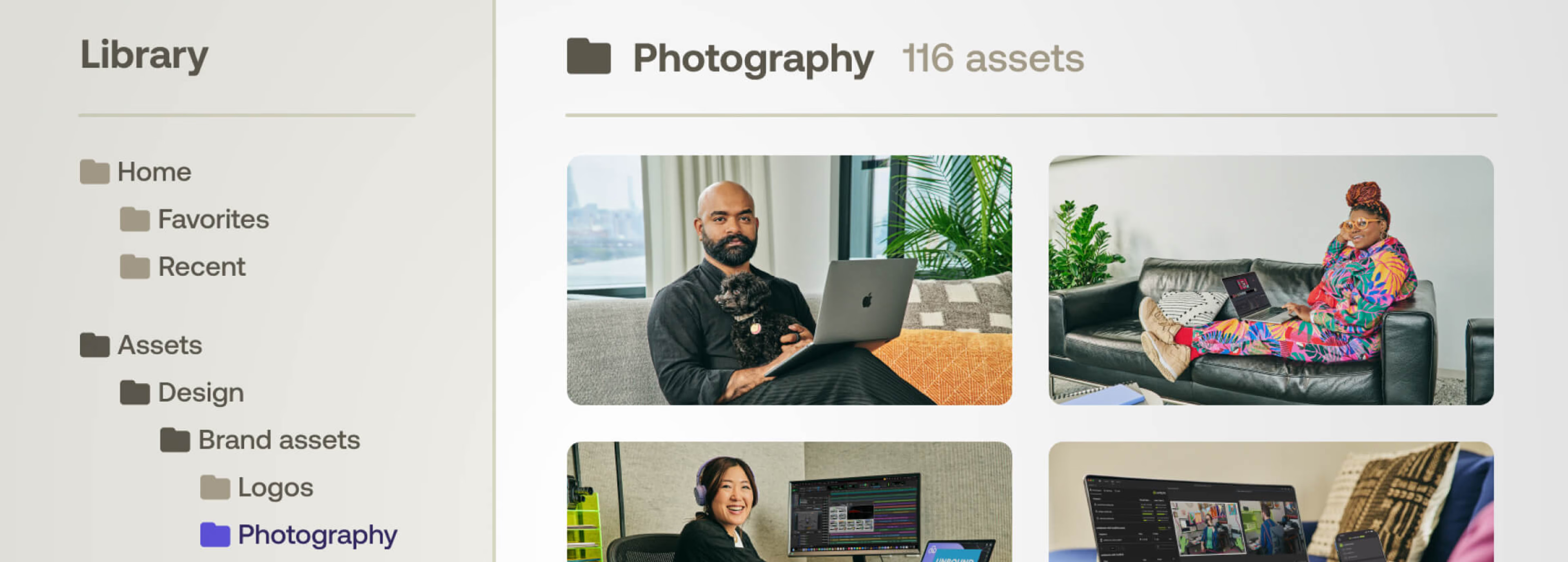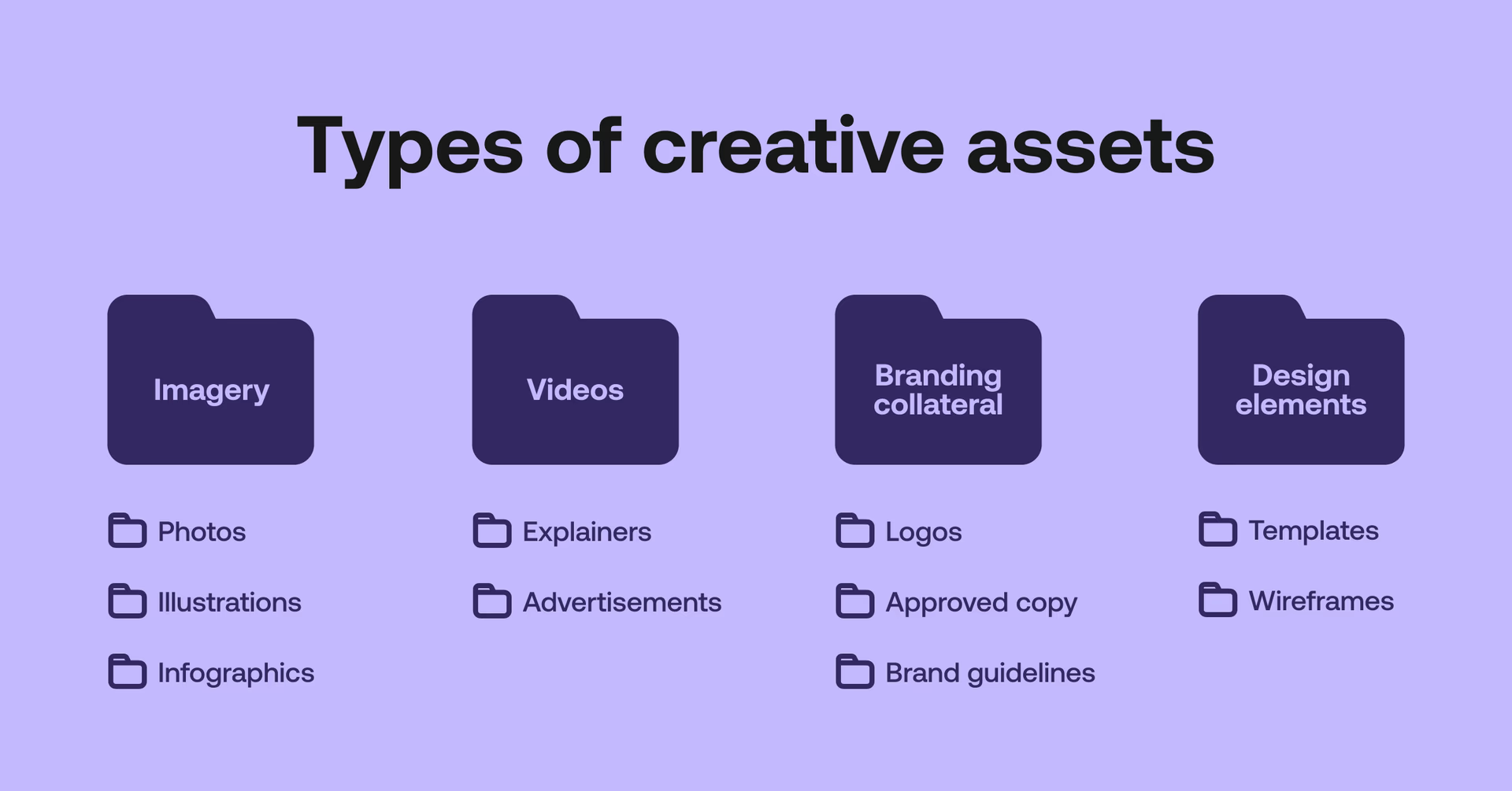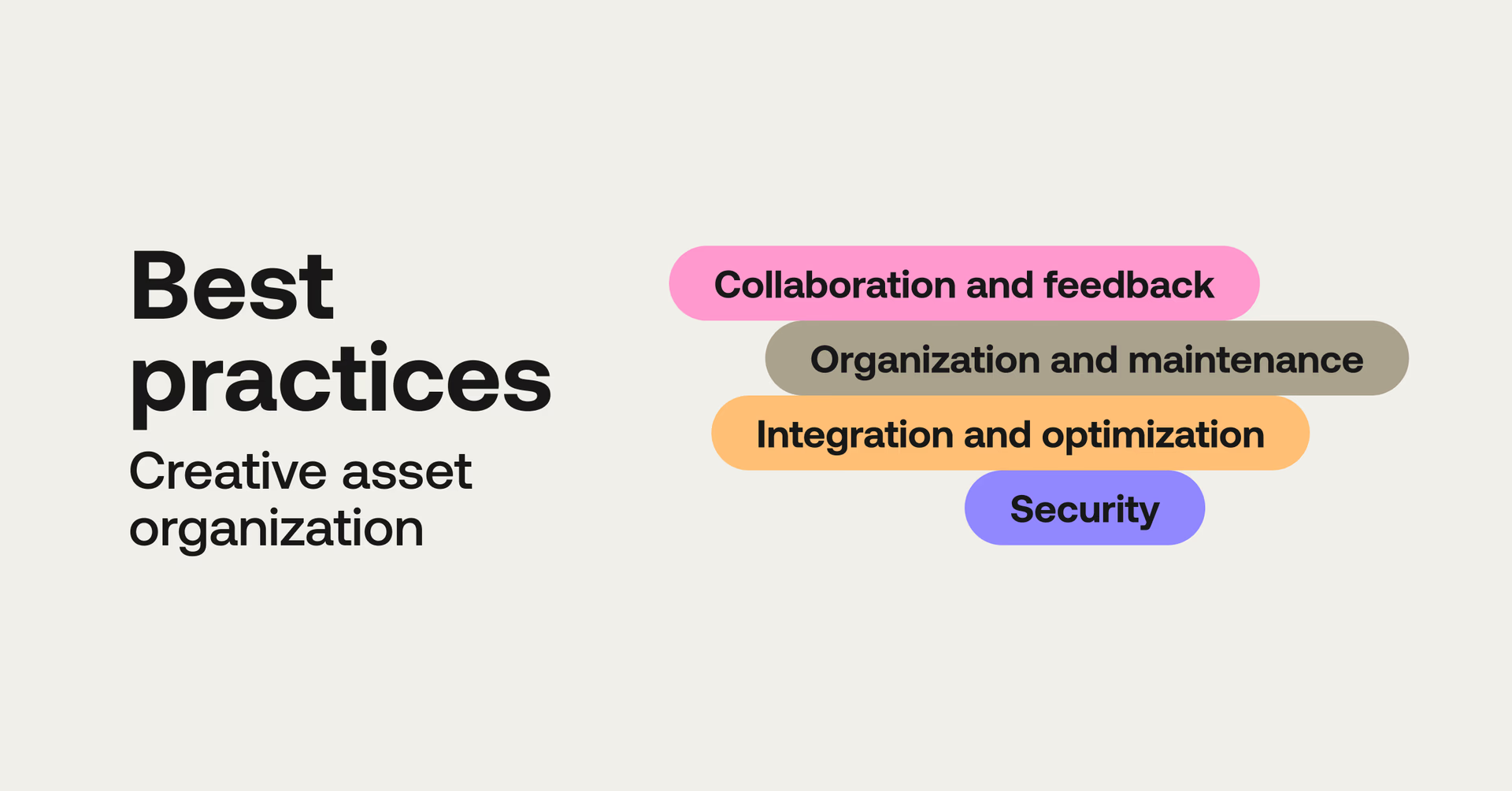Creative production
Creative asset management: top tools and best practices
February 2025
11 mins

Table of contents
- What is creative asset management?
- Why does your team need creative asset management?
- What to look for in creative asset management software
- Top 10 creative asset management tools to streamline your workflow
- How LucidLink complements creative asset management
- Best practices for organizing creative assets
- The big picture
Your files, faster.
Access any file instantly, anywhere. Collaborate in real-time from one always-up-to-date, secure cloud filespace.
If it feels like you’re pouring blood, sweat and tears into your creative assets only for them to be used once, you’re not alone.
Every piece of creative your company creates — from logos and videos to whitepapers, podcasts and beyond — takes a lot of work, from a lot of specialists.
But too often, these assets end up lost or unused due to poor organization or file management.
That’s where creative asset management comes in. More than just software, it’s a discipline that helps keep all your company’s valuable creative work in one place. Done right, it can help streamline workflows, enhance security and even unlock better analytics.
Let’s jump into all things creative asset management and explore some tips and tools that can help you better implement it at your workplace.
What is creative asset management?

Let’s start with the basics: what exactly is a “creative asset”?
It’s a pretty broad term, but it boils down to any file, material or resource created and used by marketing, advertising, design or branding teams.
Think of it like this: if it takes time, talent and tools to create, it’s probably a creative asset. These could include:
Imagery (like photos, illustrations or infographics)
Videos (including explainers and advertisements)
Branding collateral (such as logos, approved copy and branding guidelines)
Design elements (like email templates, wireframes or layouts)
So, creative asset management is all about taking care of those assets. It's the process of organizing, storing and distributing everything your team creates, so everyone can find what they need without rummaging through a digital junk drawer.
For people working on creative teams, knowing where things are and what’s up to date is non-negotiable. While there’s software to help teams big and small in this endeavor, creative asset management is also just a responsibility — or even a mindset — that your team can practice.
The good news? This means creative asset management can be applied to any of the storage, workflow and organization tools your team may already be using.
Creative asset management vs. digital asset management (and more)
Before we take a look at some software that can help you with creative asset management, let’s get our definitions straight.

The term “creative asset management” is used interchangeably and alongside several other vague terms, including digital asset management and media asset management. Some of these differences are semantic, and you’re likely to see them used differently in different contexts.
For our purposes, though:
Creative asset management is a system for organizing, collaborating on and managing creative workflows and in-progress assets. If you’re on a creative team, you can think of creative asset management as the way you and your colleagues create and retrieve your work.
Digital asset management is slightly broader, referring to the storing, organizing and distribution of finalized digital assets. It’s intended to help not just the creative team but the entire organization.
Media asset management is similar to creative asset management, in that it focuses the practice on active media production workflows (like podcasts or video production). This is also sometimes called video asset management.
Content management systems are platforms that enable the creation, editing and publishing of digital content like websites and blogs. Digital asset management is often built into these platforms or complementary to them.
Content management platforms combine the functionality of a CMS with team collaboration tools and workflow management.
Why does your team need creative asset management?
You may be asking, “Can’t people just store stuff in one place and move on?”
The truth is, both growing and established companies have a common problem. Some stakeholders know where certain assets and documents are kept, but others aren’t as invested. So when they need something they don’t have access to it.
One report found that half of employees at surveyed companies had resorted to Google to find their company’s logo. Creative teams in the thick of production need a better option.
What people are looking for is a single source of truth: one repository that contains all of the most up-to-date versions of the company’s logo, style guidelines, photography and so on. Creative asset management provides this unified repository.
The benefits of creative asset management include:
Streamlined creative workflows: teams can easily access, edit and share assets in real-time.
Version control: clear records of asset versions ensure teams have the most up-to-date files.
Better organization: tagging, categorization, file hierarchies and metadata management can keep assets well-organized and easily searchable.
Efficiency: all of your creative team’s efforts are better spent when the assets can be more easily accessed and repurposed for future projects.
Creative operations: ensure workflows stay organized and scalable, aligning people, processes, and technology for smoother collaboration.
Consistent branding: a single source of truth means that the right logos are always being used across all projects and applications.
Improved security: creative asset management platforms provide heightened security advantages over email chains or thumb drives.
Scalability: putting everything in one place facilitates better onboarding of new employees and new acquisitions, and makes collaborating with agencies and other partners easier.
Data insights: creative asset management platforms often provide analytics on asset usage and performance, so teams can optimize future creative strategies.
What to look for in creative asset management software
A lot of creative asset management software may seem superficially similar.
You just need a place to organize things, right? But each platform has a few differences that may make a big difference to your use case.

The following features are important to consider:
Scalability: in terms of price, storage and access across users, you’ll want a platform ready for where you are today and where you’re planning to go.
Security: evaluate whether tools have the security features you need, including role-based permissions for access to sensitive and WIP material.
Collaboration features: can users comment, annotate and approve work in real-time? For some teams, CAM software can be a great option for creating the work.
Automations: automating busywork like approvals and notifications can help save time.
Analytics: at larger companies, analytics about the usage of individual creative assets can spotlight what work needs to be refreshed or built upon.
Top 10 creative asset management tools to streamline your workflow
Let’s take a look at some popular tools that can help you better manage creative assets.
End-to-end tools for complex workflows
These platforms are designed for organizations managing high volumes of assets and require advanced collaboration and approval workflows.
MediaValet
MediaValet is one of the most widely used digital asset management platforms on the market. Some 90% of G2 users report that it’s easy to use. While they don’t share pricing online, they claim users recoup their investment in just 18 months.
Features:
Security features include SOC 2 certification and user permissions
Integrates with Slack, Monday, Adobe Creative Cloud and more
Track downloads and other analytics to monitor asset usage
AI-generated tags help create custom branded libraries
Bynder
Bynder is an incredibly full-featured creative asset management platform.
While it will help you manage and surface digital assets intelligently, it also seeks to be useful upstream and downstream of that, with asset-approval tools built into the platform as well as detailed usage analytics.
Features:
Rich content hub and resource community helps build fluency
Use analytics to review platform adoption and prove ROI
Educate stakeholders and improve content usage with brand guidelines
Review and approval pipeline guides content into storage system
User-friendly tools for smaller teams
Ideal for smaller teams or those new to creative asset management, these platforms prioritize ease of use and quick adoption.
Air
Air is a kinder, gentler creative asset management solution, with an approachable design, a friendly tone and transparent pricing on the site.
They’re positioned as a first stop for companies looking to implement better creative asset management, including detailed guides to help you migrate from less purpose-built cloud storage like Dropbox or Google Drive.
Features:
Create custom libraries for partners and collaborators
Enterprise-grade security includes SSO, timeout options and user permissions
Centralize comments, feedback and approval on assets in development
Extremely beginner-friendly UI and tone
Stockpress
Stockpress aims to deliver on the core promise of creative asset management: getting all of your creative assets in one place, so they can work harder for you.
Stockpress’s friendly tone and simple UI communicate a more approachable DAM solution, with affordable and upfront pricing that is rare in this product category.
Features:
Free tier and straightforward essential plan start at $39/month
Completely designed around ease of use — providing digital asset management with minimal fuss
Creative workflow tools include comments and annotations on images, videos and documents
AI-driven tags streamline upload and retrieval process
Content-driven platforms for rich media
These tools excel at handling and optimizing media-heavy content like videos, imagery and other rich creative assets.
Cloudinary
Cloudinary is a collection of APIs which collaboratively help teams manage and distribute their visual content, especially imagery and videos.
Its unique “headless” approach to asset management means that any of a huge number of APIs and “micro-services” can be used together to customize the way you manage and distribute your library of assets.
Features:
Automatically reads and tags your content
Generative AI creates original content or edits and expands existing content
Real-time video transcoding and content-aware compression deliver your videos at their best
Optimize existing content to individual marketing campaign needs
Scaleflex
Scale is built right into the name for Scaleflex, and they aren’t kidding, promising support for billions of visual assets.
If you’ve got lots of images and videos to deliver across partner websites, marketplaces and other digital destinations, Scaleflex will help you do it as consistently and seamlessly as possible.
Features:
Moderates user-generated content, flagging possible questionable content
Generative AI tools automatically tweak content to match user expectations
Create customized portals for partners, complete with custom UIs
Image and video compression can enhance load times and lead to better SEO ranking
Integrated platforms for creative and business workflows
Combining asset management with broader tools for content creation, analytics and marketing, these platforms align creative workflows with business goals.
Adobe Experience Manager
Adobe Experience Manager strives to be the center of your drive to deliver personalized marketing experiences to all potential customers.
It combines asset management with a content management system, facilitating smart repurposing of your materials across web, mobile and apps so that every segment gets an experience tailored to their interests and needs. As an Adobe product, it integrates natively with other highly used products like Photoshop and InDesign.
Features:
Create micro-sites with AI that tweak content tone and layout to engage segments
A/B test assets and designs to optimize performance
Create permissions for different roles and set asset expiry dates
Experience Manager forms pre-fill info, increasing conversion rates
Acquia
Acquia’s creative asset management software interconnects with a whole suite of other products, including an open-source CMS, site optimization and SEO tools and real-time customer analytics.
That means that your team’s creative efforts will be intricately wedded to the entire business’s performance, allowing you to repurpose assets to maximize returns.
Features:
Organize assets using upload profiles and AI-powered tagging
Online proofing to review & annotate projects
AI chatbot provides copy and design ideas
Share brand guidelines in connected portal
Versatile tools for multi-industry use cases
Tailored for various industries, these platforms adapt to different needs with customizable workflows and AI-powered automation.
Aprimo
If you’re looking to extract data from your assets, Aprimo can help. This asset management platform seeks to surface content using behavioral insights, harnessing AI to automate workflows and speed up content creation. They claim users enjoy 49% faster asset creation and a 53% reduction in asset duplication.
Features:
Integrates with Salesforce, Canvas, Google Analytics and more
Uses AI to tag, find and modify content
Surfaces content to help personalize end-user websites
Plan and track creative project scopes, including task and resource management
Brandfolder
Brandfolder makes big promises, claiming in one case study that Zoom saves 4,000 hours per year thanks to their tools. How does it do this? Smart, cloud-based asset management software focuses on what different teams need, including customized workflows for creative teams.
Features:
AI intelligently tags new assets and suggests ideal ones for templatized creative
Integrates with Shopify, Adobe Illustrator, Okta and more
Creative workflow distributes key assets across a wide array of formats, including 8K and 3D video
Brand guidelines built into the platform ensure proper usage no matter the context
How LucidLink complements creative asset management

Creative asset management is more than just software. It’s about combining your tools, systems and workflows to keep your team organized, efficient and focused on your work. That’s where LucidLink comes in.
Think of LucidLink as the glue that holds your workflow together. It’s not just another platform to manage. Our media cloud storage works just like a local drive. The only difference is it gives teams based everywhere instant, secure access to their files.
Here’s what sets LucidLink apart:
Instant access: collaborate like you’re in the same room. Your team can access even the biggest files, right away. No downloads required!
Real-time collaboration: all your files live in one secure, cloud-based filespace that updates in real-time, so everyone’s always working on the latest version.
Custom organization: set up folders, naming conventions and hierarchies that work for your team. No more hunting for that one missing file.
Top-notch security: with built-in encryption and role-based access, your creative assets are protected every step of the way.
And the best part? LucidLink fits into your workflow without forcing you to change your favorite tools. Whether you’re editing in Photoshop, managing feedback in a PM tool or reviewing assets in real time, LucidLink lets you keep doing what you do best.
Want to see it in action? Sign up for a free trial today.
Best practices for organizing creative assets

A great tool is only as good as how you use it. These tips will help you keep your creative asset management on point:
Collaboration and feedback
Encourage cross-team collaboration by asking about pain points different users may have with preexisting systems.
Encourage ongoing feedback, optimizing not only the creative asset management tools you use, but also the rollout and education you provide for them.
Ensure clear protocols for delivering feedback to in-flight creative, as well as what happens to each iteration of an asset.
Organization and maintenance
Set expiration dates for time-sensitive assets or permissions for infrequent collaborators.
Set up a system to purge unused assets periodically, keeping all your folders usable and up-to-date.
Incorporate creative templates into your asset management tools, so people can start social posts (for example) with the appropriate layouts and fonts on hand.
Integration and optimization
Integrate your creative asset management with the other tools your team is already using, including workflow management and content production.
Keep brand guidelines and style guides near relevant assets, placing them in multiple folders if necessary.
Security
Use whichever encryption and compliance features are available to you. Part of managing creative assets is protecting them.
The big picture
Your team works too hard to let your creative assets go to waste.
With the right tools and habits, your team can make the most of every creative asset.
LucidLink’s here to help: stay organized and keep your assets secure, all while collaborating seamlessly with teammates everywhere.
Curious to see how LucidLink can streamline your asset management? Try it free today.
Keep reading

Creative production
Post-production workflow: the ultimate guide for video teams
Discover how to make your post-production workflow more efficient. Organize your team, let the creativity flow, and hit your deadlines.
14 October 2025, 12 mins read

Creative production
Audio post-production: everything you need to know
Audio post-production brings performances, effects, music, and mixing together to make your story come alive. Explore the full workflow and tips here.
13 October 2025, 12 mins read

Creative production
17 marketing agency tools that make teams more brilliant (and clients happier)
Discover the 17 best marketing agency tools to streamline workflows, boost collaboration and grow your digital marketing agency.
10 October 2025, 13 mins read
Join our newsletter
Get all our latest news and creative tips
Want the details? Read our Privacy Policy. Not loving our emails?
Unsubscribe anytime or drop us a note at support@lucidlink.com.